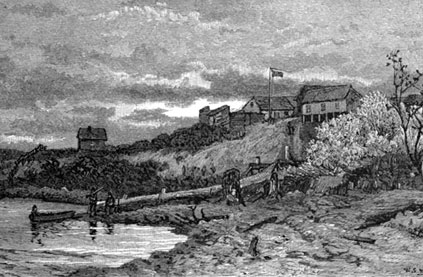We’ve launched a new web portal! Visit findhistory.nd.gov to search our collections.
Due to a road closure, the Killdeer Mountain Battlefield State Historic Site is temporarily closed.

The fur trade in North Dakota had been well established by the time of
Lewis and Clark, both in Missouri River corridor and in the Red River
valley. In the Red River valley, the North West and Hudson’s Bay
Companies established posts near the Pembina River confluence, in the
Pembina Mountains, and in the Turtle Mountains. Some of the noteworthy
traders included Charles Jean Baptiste Chaboillez, Peter Grant, and Alexander
Henry, Jr. In the journals of Alexander Henry, Jr. mention of the Lewis
and Clark expeditions to the Mandan villages is noted.
Missouri River fur traders represented British, French, and Spanish interests.
Probably the first to establish active trade relations on the Missouri
was one Jacques D’Eglise, a Frenchmen who helped to reintroduce
Spanish interests in the area. Spain had contended that it was illegal
for any other power to trade on the upper Missouri, part of what the Spanish
Crown considered its territory. Others representing the Spanish included
James McKay and John Thomas Evans. Evans in particular visited villages
in 1796 which would, just eight years later, be among those Lewis and
Clark contacted. Among some of noteworthy traders were Rene Jesseaume,
who in 1794 established the North West Company trading post between the
Mandan and Hidatsa villages. Jesseaume was still in the area when the
Corps of Discovery arrived.
Address:
612 East Boulevard Ave.
Bismarck, North Dakota 58505
Get Directions
Hours:
State Museum and Store: 8 a.m. - 5 p.m. M-F; Sat. & Sun. 10 a.m. - 5 p.m.
We are closed New Year's Day, Easter, Thanksgiving Day, and Christmas Day. We are closed at noon Christmas Eve if it falls on Mon.-Thurs. and are closed all day if it falls on Fri.-Sun.
State Archives: 8 a.m. - 4:30 p.m. M-F, except state holidays; 2nd Sat. of each month, 10 a.m. - 4:30 p.m. Appointments are recommended. To schedule an appointment, please contact us at 701.328.2091 or archives@nd.gov.
State Historical Society offices: 8 a.m. - 5 p.m. M-F, except state holidays.
Contact Us:
phone: 701.328.2666
email: history@nd.gov
Social Media:
See all social media accounts